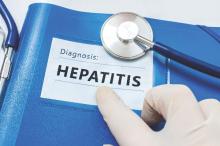Dually active antiretroviral therapy (DAART) for HIV-infected patients may be the best treatment option to also protect these individuals against hepatitis B virus (HBV) infection, according to results of a study in the Journal of Infectious Diseases.
“Vaccination against HBV remains the mainstay of preventing HBV acquisition both in HIV-infected and uninfected individuals,” states the study, led by Roger Kouyos, Ph.D., of University Hospital Zürich. “However, owing to HIV’s effect on the immune system, mounting and maintaining a protective immune response against HBV is sometimes unattainable, with a success rate between 18% and 71%.”
Dr. Kouyos and his colleagues collected CD4, CD8, and HIV-1 viral load data for 1,716 patients in the Swiss HIV Cohort Study – an ongoing, prospective cohort study that began in 1988 – and updated the data continuously during follow-up visits every 3 months, on average. Subjects were enrolled if they had negative baseline HBV serology and at least one additional HBV test after the initial one, and were either a man who had sex with men, a heterosexual, or an intravenous drug user – the three major groups examined by the study (J Infect Dis. 2016 May 18. doi:10.1093/infdis/jiw195).
DAART treatment consisted of tenofovir, lamivudine, and emtricitabine. Antiretroviral treatment history was also collected, and at follow-up examinations every 6 months, subjects were asked about occasional sex partners and frequency of condom use during the preceding 6 months. All were tested for at least one HBV marker: surface antigen (HBsAg), anti–hepatitis B core antibodies (AntiHBc), or hepatitis B virus DNA.
Of the 1,716 subjects enrolled, 177 had HBV. Of these, 86 (49%) were men who had sex with men. Most subjects underwent at least two HBV tests, with the median time between tests being 29 months (range of 12-58 months). In the transmission group, the overall incidence rate of HBV was 16 (95% confidence interval, 14-19), while it was 25 (21-31) for men who had sex with men, 9 (6-11) for heterosexuals, and 28 (21-38) for intravenous drug users.
DAART, however, was shown to significantly reduce HBV-infection risk. Univariate analysis yielded a hazard ratio of 0.4 (95% CI, 0.2-0.6), and multivariate analysis showed even more significant effects for intravenous drug users (3.8, 2.4-6.1), men who had sex with men (2.7, 1.7-4.2), and those who had unprotected sex (1.9, 1.4-2.6).
“Our study confirms the importance of viral suppression (and the implicit adherence) in reaching the protective effect of DAART,” the authors concluded, noting that “Our study adds to the growing body of evidence that early antiretroviral therapy initiation, regardless of CD4 counts, has a strong beneficial public health impact, including preexposure prophylaxis of HBV coinfections.”
The study was supported by the Swiss HIV Cohort Study, the Swiss National Science Foundation, the European Community’s Seventh Framework Program, and the Union Bank of Switzerland. Dr. Kouyos reported travel grants from Gilead. Other coauthors reported research, educational, and travel grants from Roche, Abbott, Bristol-Myers Squibb, Gilead, Astra-Zeneca, GlaxoSmithKline, Pfizer, and Astellas.


